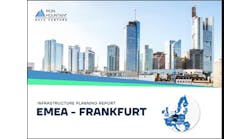The Data Center Frontier Executive Roundtable features insights from industry executives with lengthy experience in the data center industry. Here’s a look at the insights from Danielle Rossi, Global Director – Mission Critical Cooling, for Trane.
Danielle Rossi is Global Director – Mission Critical Cooling for Trane. Danielle has 17+ years in data center solution design and engineering for hyperscale, colocation, enterprise, edge, and government environments.
In her current role, Danielle manages global mission-critical cooling products and processes to provide a standardized deliverable for customers executing projects worldwide.
Here's the full text of Danielle Rossi's insights from our Executive Roundtable.
Data Center Frontier: What are the main considerations for the procurement and deployment of mechanical and electrical infrastructure in data center adaptive reuse projects and sites, versus for new construction? And to what degree are supply chain concerns presently a factor?
Danielle Rossi, Trane: The recent increases and ongoing changes in density requirements are making existing site adjustments difficult.
The considerations include available site power, retrofit costs, and potential downtime versus new site development.
If we assume no additional power capacity to be added to a site and a company is looking to adjust an existing data center to liquid cooled or hybrid cooling, the likely retrofits will include increase of floor supports, additional piping/piping infrastructure, and will result in a smaller load footprint in a larger space.
If additional power capacity is assumed, the same retrofits will need to be done with the addition of increased power feeds and heat rejection at the location.
Additional power, power supporting equipment, and heat rejection are the longest lead time items in the industry, increasing time to deployment and, in this case, redeployment.
The above mentioned considerations result in the increase of product reuse in place of site reuse.
Depending on the existing facility, customers are now considering repurposing existing long-life items such as generators, chillers, transformers, and switchgear to new facilities from their existing locations.
Once that transition is made, the existing building can be retrofitted, or the land can be used for a new build, optimizing the customer's existing property.
Data Center Frontier: How do you see service level agreements (SLAs) evolving for data center equipment and expansion projects in the age of rapidly escalating AI, HPC and cloud computing demand?
Danielle Rossi, Trane: With the increase of AI, we are seeing drastic rises in density.
Supporting high densities during outages and maintenance requires extra redundancy and planning.
Going forward, we will see more stringent plans for servicing, including connected and virtual services, as well as long-term vendor-provided scheduled maintenance.
Customers have already begun specifying longer-range service plans and more detailed spare parts kits.
Along with these requirements, requests for vendor service capabilities are increasing.
Global technician coverage and area-specific availability have always been a consideration but are increasing in priority.
Data Center Frontier: What are some key project management tips and strategies for facility operators and developers seeking to balance a need for great versatility with a mutual need for great specificity in data center designs for the AI era?
Danielle Rossi, Trane: Future-proof, or near future-proof, planning is key to decreasing the future cost and downtime of day two changes to a site.
Ensuring site design can accommodate future liquid cooling upgrades, higher electrical inputs, and possible load density expansion is the best way to guarantee future versatility.
Additionally, it is important to adapt to changing requirements over time.
If a site is pre-planned properly to support future changes and growth, the site operator will be able to pivot designs as needed for an application close to real-time.
We will see more hybrid cooling designs, particularly in future retrofits, and site operators should be able to adjust to those needs without any substantial site redesign or construction.
Data Center Frontier: What's the best path forward for innovation in data center infrastructure optimization, in terms of engineering for ongoing energy efficiency gains and maximum clean energy utilization in the face of AI's exponential power requirements?
Danielle Rossi, Trane: Going forward, data center planning will need to be done more holistically, thinking outside the site.
Until this point, standard considerations for site choice included power availability, cost of power, ambient temperature, ease of access, etc.
Long term planning will also need to require considering possible heat reuse on site or nearby and even site power creation.
Several countries have legislation in the EU requiring heat reuse for new data center projects, and more countries are looking to do the same.
There are many ways to implement heat reuse, but most designers stop after ruling out a district heat option.
Heat recovery can be done by many chillers and heat rejection systems and is an easy addition to a design. The recovered heat can be used for indoor agriculture, fish farming, industrial laundromats, adjacent office space, community pools, etc.
Potential heat reuse options should be considered before site selection to best benefit efficiency.
There is no bigger topic in the data center space than power shortages. There are moves toward secondary and tertiary markets, as well as discussions about pairing with or utilizing existing nuclear facilities to gain access to power.
Additionally, alternate conversations about dedicated sustainable power, such as wind, water or solar, have been increasing.
The use of any of these, in addition to product-specific energy saving methods such as controls and thermal or energy storage, will optimize the efficiency of the site in the best way possible.

Matt Vincent
A B2B technology journalist and editor with more than two decades of experience, Matt Vincent is Editor in Chief of Data Center Frontier.





